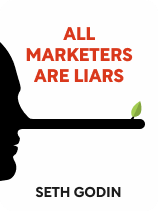

This article is an excerpt from the Shortform book guide to "All Marketers are Liars" by Seth Godin. Shortform has the world's best summaries and analyses of books you should be reading.
Like this article? Sign up for a free trial here .
Do you effectively engage in competitive marketing? Do you know how to come out on top in the marketplace?
Competition is unavoidable, so you must learn to handle it well. Seth Godin shares four strategies to tell your story in ways that give you an edge over the competition.
Read more to learn these competitive advertising strategies.
4 Competitive Advertising Strategies
Competition in the marketplace is inevitable. How can your marketing be authentic when there are so many other marketers trying to be authentic too? What happens if someone is already telling the story you want to tell? Godin presents a few competitive advertising strategies to handle competition.
Tell a Similar Story in a Different Market
If you’re having trouble finding a place to start with your story, Godin recommends telling a similar story to one someone else is using in a different market. If you can identify an existing worldview and a story that already works, you can adapt that strategy to your new product. The key here is to mimic a story from someone in a different market, selling a different product.
| Determine Your Competitors By identifying who is and is not a competitor, it’ll be easier for you to determine where to look for inspiration and when to appeal to a different worldview. As you develop your marketing for a product, it’s important to situate yourself within the marketplace and identify your friends and foes. Consider completing a competitor analysis by examining your competition, what works for them, and the different kinds of stories they’re telling. Competition can fall into three categories: Primary competitors: When you hear “competitors,” the first companies or people that come to mind are probably your primary competitors. They share a similar product or service to your audience. Wendy’s and McDonald’s are primary competitors. Secondary competitors: These companies offer similar products to a different audience, or they offer a similar product of greater or lesser quality. For example, Tiffany is a secondary competitor to Kay Jewelers. Both sell jewelry but for different audiences and at different price points. Tertiary competitors: These competitors are loosely related to your company or industry. They don’t pose much of a threat unless they decide to expand into your market. Gatorade and Under Armour are tertiary competitors because they’re loosely related by the worldview they address ( that values athletic excellence). But unless Under Armour decided to create a line of sports drinks, they don’t pose a threat to Gatorade. |
Tell a Better Story for a Different Worldview
But what if the story you want to tell is coming from someone with a similar product? If you’re entering a market where someone else is already succeeding with their story, don’t try to tell their story better. If consumers have already bought a competitor’s lie, they’ll stick to that story, and it’ll be hard to change their bias. Godin says the best tactic is to tell a different story to a different worldview.
For example, Tesla has found success with its luxury electric vehicles. While they were not the first to produce electric cars, they took a new approach to marketing electric cars. Whereas manufacturers focused heavily on the environmentally friendly marketing angle of electric cars, Tesla associated their cars with a worldview that values luxury and technological advancement.
| Learn From Your Competition In The 22 Immutable Laws of Marketing, Al Ries and Jack Trout advise that you 1) define your brand in one word, and 2) don’t use another brand’s word. If you use their word, you’ll probably end up strengthening the word’s association with their brand. That doesn’t mean you should completely ignore your primary competition. In Ogilvy On Advertising, David Ogilvy suggests you look at your competition’s ads, because you might be able to adopt (or better yet, adapt) techniques that are proven to work for that specific industry. You can also pretend to be a customer at a competitor’s store or site. This can help you identify points of encounter and potential first impressions. Were their employees nice to you? What was the atmosphere of the store? Do you like their color scheme on their website? What strengths and weaknesses do your competitors have? Answering these questions can help guide what kind of consumer experience and story you want to craft. |
Tell a Story to a Niche Within an Existing Worldview
You can also try to narrow down an existing worldview. In other words, find a niche within a niche. Godin notes that people can hold multiple (and often opposing) worldviews, so you should be able to find a more specific subset of people within a larger worldview.
When music streaming services started becoming popular, Spotify and Pandora were two of the largest competitors. While they both appealed to a larger worldview (“paying for access to a library of music is better than purchasing to own music files”), Spotify found a niche within that worldview. Their story focused on creating individualized playlists for every mood. Narrowing the larger worldview worked in Spotify’s favor.
| Create a New Niche In Blue Ocean Strategy, W. Chan Kim and Renée Mauborgne suggest that one step in creating an uncontested market is figuring out what makes your product unique. If you need inspiration on finding a place in an innovative market, consider these tactics: Think about how customers weigh price with performance. What factors motivate them to buy better quality products? What features aren’t as important to them? Think about appealing to under-served buyers. There are three kinds of buyers: the one who authorizes the purchase, the one who sets up the product for use, and the one who actually uses the product. Are any of these three buyers neglected in the current market? Try catering to their needs. Think about adding emotion or function. If your market typically appeals to function or logic, consider adding emotion to make your consumer feel something. If your market typically appeals to emotion, add logic. Find new ways to appeal to different ways customers think and experience the world. |
Tell a Story to an Evolving Worldview
Another tactic is to predict how a current worldview might evolve. Because worldviews are susceptible to change, Godin says this gives you the opportunity to adapt your marketing stories, or even guess how current worldviews may change. If you can predict how an existing worldview could evolve, you can frame your story to it and ideally beat your competitors to the market of the new worldview.
| Making Better Predictions to Encourage Innovation Predicting how a worldview might evolve is arguably a riskier tactic that requires some creativity and innovation. However, several authors offer advice for making better predictions and becoming more innovative. In Originals, Adam Grant explores common practices among innovators. If you’re wanting to become more innovative, start by generating lots of ideas. Not all of them will be good ones, but that’s okay—the most important thing is to get in the practice of using your imagination and questioning why the world is the way it is. As you practice generating more ideas, try Philip Tetlock and Dan Gardner’s advice in Superforecasting: Broaden your horizons. By exposing yourself to new ideas, perspectives, and worldviews, you might find inspiration for your prediction. It’ll also make it easier to generate ideas from different perspectives. Try reverse-engineering. Start with your conclusion or the answer your product provides. Then work your way backward to figure out how to get from your conclusion to your current problem. To get into the habit of practicing reverse-engineering, you can try it with current worldviews—think about how past worldviews evolved into their current ones. Attack your own conclusions. If you think you’ve found an answer, try thinking of counter-arguments or ways it could work differently. You might think of a better prediction. It’s also important to understand that innovation is a process, not a single event, so don’t put too much pressure on yourself to change the world. |

———End of Preview———
Like what you just read? Read the rest of the world's best book summary and analysis of Seth Godin's "All Marketers are Liars" at Shortform .
Here's what you'll find in our full All Marketers are Liars summary :
- The difference between lying and telling a great story
- How to better understand your customer
- How to overcome common obstacles you’ll encounter in marketing






